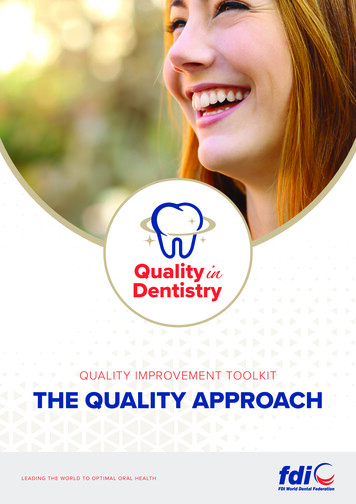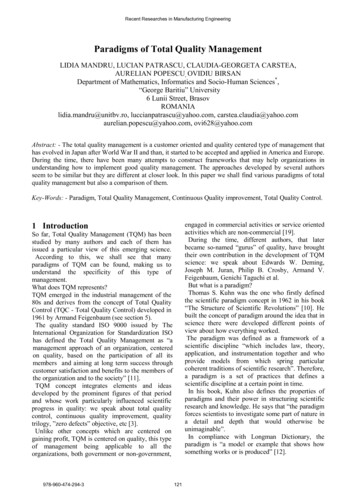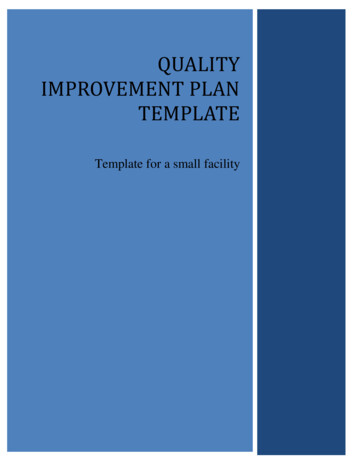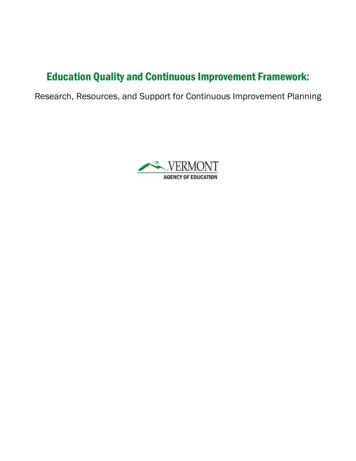
Transcription
QUALITY IMPROVEMENT TOOLKITTHE QUALITY APPROACHL E A D I NG T H E WO RL D TO OPTIMA L ORA L HEA LTH
AUTHORS AND CONTRIBUTORSAuthorsDr Roland L’HerronHonorary President of Les Chirurgiens-Dentistes de FranceParis. FranceDr Michael Sereny, DentistPrivate Practice Hannover, GermanyContributorsDr James ZenkGeneral Dentist - Retired from private practiceClinical Assistant Professor at University of Minnesota School of Dentistry - Outreach ClinicsChair, FDI Dental Practice CommitteeDr Mick Armstrong BDSGeneral Dental PractitionerBDA Board MemberVice-Chair, FDI Dental Practice CommitteeDr John Milne FFGDP BChDGeneral Dental PracticonerNational Dental Advisor Care Quality CommissionFDI is an international, membership-based organization that serves as the mainrepresentative body for more than 1 million dentists worldwide, active in some200 National Dental Associations (NDAs) and specialist groups in close to 130countries. Founded in 1900, FDI is a pioneer in the field of modern dentistry.As a convener of the oral health community, FDI fosters exchange anddevelops a common vision to advance the science and practice of dentistry.FDI delivers innovative congresses, campaigns, and projects to address theglobal oral disease burden and improve oral health. As the leading globaladvocate for oral health, FDI strives to achieve our vision of leading the worldto optimal oral health by working at both the national and international level.FDI is committed to representing the interests of member NDAs globally to helpsupport their national efforts to raise awareness on oral health. FDI transformsthis commitment into action through active engagement with the World HealthOrganization, as well as other United Nations agencies, health organizations,governments, and global partners to ensure that oral health is recognized as anessential component of general health and well-being.3FDI World Dental Federation
CONTENTS1. Introduction 32. Understanding what we are talking about 43. Stakeholders: Partners for quality improvement projects 54. The legal and regulatory context 65. Fundamental principles of the quality approach in healthcare 75.1.Listening to and gathering information from patients 75.2.A participative approach 75.3.An approach for optimizing working conditions 75.4.A process-oriented approach 85.5.Continuous quality improvement 85.6.Measurements 85.7.The PDCA Method or Deming Cycle 95.8.Quality improvement projects for all clinical settings 106. Implementation of the quality approach in a collective project 116.1. A steering committee to pilot the project 116.2. Taking stock: A factual description of the starting situation 116.3.The choice of theme 116.4.Finding the project means: The search for partners and project funding 126.4.1. Partners 126.4.2. Project funding 126.5.Ensuring internal and external communication 126.6.Training the project participants 127. Scientific support 138. The practical implementation 149. Conclusion 15Annexe 1 16Annexe 2 18References 19Quality Improvement Toolkit4
01.INTRODUCTIONToday, across the world, the provision of healthcare has a prominent place in national politicalsystems, and oral health is increasingly accepted as an integral part of general health.Simultaneously, as access to information becomesincreasingly easy, consumers become increasinglydemanding, whatever they are consuming – and oralhealthcare is no exception. Patients no longer wantto be passive; they want to contribute actively to theirtreatment and fully understand the details of theirtreatment plans, which is highly desirable.If the goal of providing a safe, transparent and qualityservice for patients is a clearly stated priority fordental teams worldwide, defining quality in dentistryremains particularly challenging as there are differentdefinitions and frameworks to assess quality care.Moreover, in dentistry, the discussion on quality isoften misunderstood and reduced to the quality ofclinical acts without taking into account the socialand economic environment (healthcare system,remuneration, costs), the organization of the practice,and often without taking into account the peopleinvolved, namely patients and staff.Populations have three main requirements: qualityof care, safety of care - two fundamental andinseparable treatment values - and transparency,including the right to be informed about thetreatments envisaged, the materials used, thepossible risks associated, the expected outcomes,and the treatment costs.1This document outlining a general framework forimproving quality and an appropriate toolkit takes intoaccount these different aspects and the involvementof all parties concerned. It does not propose astandard level of quality that can be achieved in everycountry, nor does it define a minimum level of quality.The document aims to outline criteria that can beused by institutions, funding agencies, professionalorganizations and practitioners to enable them to setup systems that can help improve quality, whatevertheir needs, resources, and objectives.In order to meet the requirements of quality, safety,and transparency, the authorities in charge ofthe population’s health adopt legal or regulatorymeasures (sometimes under media pressure andsolely in the name of the precautionary principle)that become increasingly restrictive for healthcareprofessionals.1This situation did not escape FDI: In 2017, FDI made apolitical declaration on quality in dentistry and set upa working group to produce a framework for a qualityimprovement toolkit.5FDI World Dental Federation
02.UNDERSTANDING WHAT WE ARETALKING ABOUTQuality of care has long been synonymous with the quality of practice, but a model adoptedfrom the industrial field has gradually developed in the health field to meet the expectationsof patients and other partners involved in care. Dentists, like other health professionals, arerequired to put in place systems that help improve the quality and safety of their care: this iscalled the quality assurance approach.2What is quality?Quality assurance:According to the International Standards Organization(ISO) quality is “the set of characteristics of an entitythat give it the ability to meet expressed and impliedneeds.”3“All of the pre-established and systematicallyimplemented provisions under the quality systemand demonstrated as needed to give the appropriateconfidence that a product or service will meet thequality requirements.”3Quality approach:This ensures an organization has a system in place todetect, measure, and correct potential shortcomings,and implement appropriate preventive actions.It can be defined as: “the commitment of theproducer (the healthcare provider) to the consumer(the user, the patient)) that guarantees the reliabilityof the product (service) by implementing validatedprocedures (conformity to rules of good practice andcontrols).”Quality improvement:The element of quality management that focuses onincreasing capacity to meet quality requirements. Itfocuses on: efficacy, i.e. the achievement of results that relateto the initially planned quality objectives; efficiency, i.e. the relationship between theachieved result and the consumed resources(the notion of return, quality is not independent ofthe economy).5But “quality approach” is not a standard term andtherefore can have a very broad meaning and refersto a “way of acting” in pursuit of quality.2 Applied tothe health field, the quality approach must thereforeensure the “quality of care.”Quality of care:“An approach that should ensure that each patienthas the combination of diagnostic and therapeuticprocedures that will ensure the best health outcome,in accordance with the current state of medicalscience, at the best cost for the same outcome,with the least iatrogenic risk and for their greatestsatisfaction in terms of outcome procedure andhuman contact within the healthcare system.”4Continuous quality improvement:The adjective “continuous” is used to indicatethat the quality approach aims to gradually andpermanently reduce dysfunctional processes,patient complaints or risk.Whereas quality assurance is intended to giveconfidence that it will inevitably achieve a specifiedlevel of quality, continuous quality improvementinstead focuses always ahead in the direction ofbetterment.RECOMMENDATION: To spend time on these definitions will make communicationeasier and more effective.Quality Improvement Toolkit6
03.STAKEHOLDERS: PARTNERS FORQUALITY IMPROVEMENT PROJECTSTo achieve a satisfactory level of quality, all healthcare stakeholders should be involved andmade aware of their responsibilities: Policymakers and institutional players: In theirendeavours to promote the well-being of theircountry’s populations, they must implement anadequate and efficient healthcare system andhealthcare delivery structures that meet the needsof the country. The necessary resources mustbe provided by public funds or private insurancefunds so that everyone has access to quality care.properly and dentists and their auxiliary staff toreceive adequate remuneration in relation to theirresponsibilities and their competences.Funding agencies: Whatever the chosen systemof healthcare delivery and funding method inthe given country - private or public – qualityis not possible without appropriate financialresources, suited to the healthcare facilities andthe qualifications of the healthcare providers.In countries where private practice is the norm,medical procedures and treatments should bepriced at their true value and revaluated regularlyin order to enable dental practices to function Dentists and staff: They should receive the mostextensive and comprehensive training possible toensure a high level of professional competence.Training is a core component of quality of care.Continuing professional education throughoutone’s working life, whether compulsory orvoluntary, also support the constant improvementof the quality of care. Patients: The quality of dental care does not implyonly technical and clinical considerations. It alsolargely depends on the patient’s understandingand active cooperation. Improving the qualityof dentistry therefore implies that patientexpectations are adequately taken into account.RECOMMENDATION: Be sure not to lose sight of the fact that quality assurancerequires strong institutional will, appropriate structures, adequate financial and humanresources, a high standard of training for personnel, and fair remuneration of personnel.7FDI World Dental Federation
04.THE LEGAL AND REGULATORY CONTEXTThe safety of care is governed by a legal framework set by the laws and regulations in forcein each country. It cannot be exempted from these obligations.The quality approach is also relevant to the environment in which care is provided, i.e. with the set up of thedental office or clinic and the services provided. The quality approach has to take into account the following: Administrative regulations: The “scope of practice” for dentists and staff can be defined and limited.There may be an obligation to take out civil liability insurance or various other types of insurance. Health regulations and good practice recommendations: Specific measures for patient safety may berequired, e.g. regulation on ionizing radiation. Economic regulations: Dental fees can be set by insurance companies, health authorities; freely orregulated; the practitioner must provide the patient with an estimate for the cost of their care in advance. Ethical regulations: A code of ethics can define the rights and duties of practitioners in their relationshipwith patients. An official body, most often the council of the relevant professional association, isresponsible for ensuring that these ethical rules are followed. Labour regulations: As more practitioners choose to own their practices with a team of salaried staff, aprofound knowledge of labour law applicable in their country is necessary.RECOMMENDATION: It is necessary, in the framework of implementing a qualityapproach in dental practice, to remind practitioners of the different regulations in placein writing, including exact references to the relevant documents. Quality improvementprojects can in no case ignore or be in contradiction with these regulations.Quality Improvement Toolkit8
05.FUNDAMENTAL PRINCIPLES OF THEQUALITY APPROACH IN HEALTHCARE5.1. Listening to and gathering information from patientsBeing attentive to what patients say is crucial because patients’ satisfaction is conditioned by how they arelistened to.There may be a gap between a patient’s expectations in terms of quality and the patient’s perception of thecare received, which can be referred to as a satisfaction gap. In a similar way, there may be a gap betweenthe practitioner’s desired level of quality, i.e. strict conformity of the treatment outcome with the set treatmentobjectives, and the quality effectively achieved.There may also be a difference between the patient’s expected quality and the practitioner’s desired quality,which can be referred to as a design gap.2Feedback can be actively gathered from surveys, interviews, questionnaires and also by monitoring commercialsocial media. It may be appropriate to respond in these fora but not in a negative way.Monitoring and responding to formal complaints is a crucial part of quality improvement. All complaints shouldbe responded to, recorded and regularly audited.RECOMMENDATION: A quality approach aims at reducing these gaps; listening topatients provides information that can help identify problems before they arise.5.2. A participative approach Improving processes requires reflection from all those who use these processes daily. This meansthat all the analyses, decisions and implementation must be conducted in close collaboration with allmembers of the dental team (dentist, dental therapists, dental hygienists, dental nurses, receptionists,maintenance staff, etc.)5 To ensure that all participants fully commit to the project, the objectives must be clearly defined anddetailed. All involved should fully understand the approach, especially that it is a continuous process overthe long term as opposed to a series of punctual obligations.RECOMMENDATION: make sure that these conditions are met because thecontribution from all involved will lead to relevant suggestions for improvement.Indeed, many of the changes observed at the end of an improvement project resultfrom the quality of the initial diagnosis made by those involved in the process andfrom the relevance of the chosen improvement measures.5.3. An approach for optimizing working conditionsParticipants need to be given good reasons to commit to the project. This can be achieved by inviting themto consider their organization, their work methods, their communication with others - patients, collaborators orcolleagues - and to envisage ways of improving these various aspects of their work to lessen the organizationalmalfunctions that cause stress and, consequently, lower quality.6A truly inclusive team approach is necessary so that colleagues regard the project as a benefit that will leadto a better working environment and job satisfaction, rather than an imposition. Financial incentives might beconsidered, but the feeling of being recognized for a commitment to constant quality improvement should notbe underestimated.RECOMMENDATION: A quality approach provides an opportunity to solve problemsthat have stayed unsolved because of lack of time, will, or information.9FDI World Dental Federation
5.4. A process-oriented approach The process approach deals with the identification and description of all the operations that followone another from the patient’s first contact with the care facility to the moment the patient leaves afterhaving received treatment. Processes, therefore, reflect reality, i.e. what happens in practice. The processes are drawn up freely by all participants, with the members of the dental team in theforefront. The ensuing process mapping provides an objective view of the dental office’s activities,beyond the artificial boundaries of the organizational chart5. The process, therefore, helps to identify not only key processes but also shortcomings (missingresources, duplicates, etc.), in particular in the organization of the interfaces.5RECOMMENDATION: This analytical approach helps to improve quality by improvingcollective efficiency.5.5. Continuous quality improvementThree methodological principles characterize the continuous process of quality improvement: Any activity may be described as a process. Quality improvement always results from the step-by-stepimprovement of processes and can be aimed for whatever the initial status. Processes are always analyzed in their initial functioning. This helps to identify real-life dysfunctionsand to define actions for improvement with the persons concerned. The effectiveness of any improvement should be measured objectively.5RECOMMENDATION: The approach is iterative and aims at achieving successiveimprovements, hence the reference to continuous improvement.5.6. Measurements Measurements are the objective assessment of the actions taken. They provide an objective view of the existing level of quality and of the progress made as a result of theactions for improvement that have been conducted. Measurements, therefore, prove that progress hasindeed been made. They also give value to the work accomplished and confidence to the participants in their capacity tocontinuously improve the quality of the services they provide and their work organization.5RECOMMENDATION: Listening to patients will identify problems that can best betackled in a team approach, using collective efficiency to break down all operations intosmaller processes to improve performance and enhance the working conditions for all.Quality Improvement Toolkit10
5.7. The PDCA Method or Deming CycleSeveral methods are available to assess the results or the progress of the continuous quality improvementapproach based on process analysis. The most widely used is probably the PDCA method (Plan, Do, Check,Act), otherwise known as the Deming Cycle, after the name of its inventor. The Deming Cycle is a four-stepiterative method represented by a wheel. Quality improvement is therefore obtained over time by the repetitionof the cycle.5Quality ImprovementContinuous ImprovementarddStanarddStanConsultation through StandardisationTimeDepiction of the PDCA cycle (or Deming Cycle). Continuous quality improvement is achieved by iteratingthrough the cycle and consolidating achieved progress through standardization.[source Wikipedia/Johannes Vietze https://en.wikipedia.org/wiki/PDCA]PLAN (P):Establish quality objectives and processes required to deliver the desired results.DO (D):Implement the plan, carry out the objectives from the previous step.CHECK (C): Check that the project is moving towards the objectives, study the results, measure effectiveness.ACT (A):React and improve. Take the necessary corrective measures to reduce gaps and make sure thatwhat has been achieved will remain stable. Each turn of the wheel takes the project higher until thetarget is finally reached.The WEDGE underneath the wheel prevents the project from falling back to a previous level. It represents aconsolidation and sustained efforts over time.Example:Plan: Avoid stress with emergency patients Do: Direct emergencies to a time reserved for them Check: ask staff (and interview patients) if this method reduces stress Act: Adjust reserved time to the need.RECOMMENDATION: All objectives are rarely achieved in the first assessment. It isimportant to maintain and sustain good results and to define new corrective actions tobe implemented in the following cycle.11FDI World Dental Federation
5.8. Quality improvement projects for all clinical settingsThe basic principles for quality improvement projects can be implemented in the following ways: In a collective project initiated by a regional or national dental association for their practices anda wish to bring substantial improvements within their dental practice. The aim should be to not onlyincrease patient satisfaction but also other motivations shared with funding bodies or the national healthauthorities, that may translate (for example) into an increase in treatment fees. In a national healthcare system, under the supervision of the country’s health authorities, to improve thesystem’s efficiency. In a single dental practice or a group practice, organized by the dentist(s) and their team(s).RECOMMENDATION: Whatever the case, the principles remain the same and theresults must always be quantifiable so that the initial and final situations may becompared, and the level of success or failure of the project may be assessed.Quality Improvement Toolkit12
06.IMPLEMENTATION OF THE QUALITYAPPROACH IN A COLLECTIVE PROJECTAny decision to act in favour of improving quality must correspond to a request made,preferably by colleagues facing problems on the ground. In different care systems, thisdecision can also emanate from the highest level of the hierarchy.However, implementing a quality approach requires method and rigour. Several factors are indispensable;structuring the approach is just as important as training the participants, choosing the methods and tools, etc.6.1. A steering committee to pilot the project The steering committee has both a strategic and a political role and should be set up as early aspossible. The committee should comprise the project partners, experienced colleagues, and various experts (inmethodology in particular). It is in charge, among other things, of defining the project theme, setting the objectives, providing thenecessary means to achieve them, making sure all participants receive adequate training, and ensuringcommunication.5RECOMMENDATION: The objectives and expected results, on the healthcare level butalso the political level, should be clear and precise. Considering the issues at stake,strong commitment to the project is a guarantee of success.6.2. Taking stock: a factual description of the starting situationThis initial analysis will be used as the basis to assess results and improvements and will also help to determinethe project theme, by bringing to light the problems that need solving. What are the weak points? What are the practitioners’ demands? Safety of care? Emergency management? Appointment scheduling (patients wait too long to get an appointment)? Something else?RECOMMENDATION: It is the answers to these questions that will determine the choiceof theme, hence the importance of this phase of situation analysis.6.3. The choice of themeWhen the quality approach initially began being implemented, it was oriented mainly towards the theme ofcare safety. But gradually, especially in the Anglo-Saxon world, quality improvement has also focused on otherimportant factors that can be categorized into four main categories (see Annexe 1 for further information). Safety: Patient safety is paramount in dentistry. Effectiveness issues: The system does not deliver the expected performance. Efficiency: The output you get for a unit of input. Responsiveness issues: The system does not address the needs of its patients satisfactorily7.13FDI World Dental Federation
6.4. Finding the project means: The search for partners and project funding6.4.1. PartnersA project on safety - infection control at the dental practice for example - may be of interest to health authoritiesin charge of population safety, or practice liability insurers. It is very difficult to carry out a project alone. Hence there is the need to approach partners in thesocial system and dental care funders who might share the same interest in improving the quality of theproposed theme. Partners may be different depending on the theme chosen and their interest in the objectives (see‘Quality stakeholders’ section). All partners need to strongly support the project, in writing, so that there is no misunderstanding aboutthe expectations of everyone, including funders. The leadership remains with the initiator of the project and not with the financial partners so that it isnot diverted from its original objectives. Therefore the project centers always on the interest of patientsand never loses sight of their well-being and safety.6.4.2. Project funding Fair co-financing between the initiator of the project and the partner should be considered as muchas possible. It can be tempting to have the bulk of the project financed by investors or even by thedental industry. The initiator then runs the risk of the funder taking over the leadership, which might beproblematic if a conflict of interest arises. The project’s budget should be precise and take into account all expenses, especially those that cansometimes be neglected, for example, the production of internal documents, e.g. briefing note for theparticipants, external documents, e.g. project promotion in the media, and also the training of trainerswho will have to follow up and support colleagues.6.5. Ensuring internal and external communication Internal communication about the project through an internal documentary system will help to share themeaning of the project with all participants and to federate them around a common goal. External communication will contribute to emphasizing the importance of quality for the project partnersand their commitment to an initiative that will benefit mainly the patients.6.6. Training the project participantsImplementing a quality approach implies providing information and training tailored to the needs of eachparticipant so that they have the means to measure the decrease in the gap between their practices and the setobjectives (the frame of reference). The training will aim at giving each participant the basics of a culture of quality and, where necessary, itwill also detail the principles and concepts of quality, methods and tools, and technical aspects.5RECOMMENDATION: It is the application of this quality approach method that willallow the participant to measure how the gaps between their practice and the definedobjective are reduced.Quality Improvement Toolkit14
07.SCIENTIFIC SUPPORTStructuring a quality approach project also requires, like any other large-scale collectiveproject, scientific support. Scientists should represent the different stakeholders accompanied by experienced colleagues, andvarious experts (in methodology in particular, because a frame of reference should be drawn using aspecific method - see Appendix). Scientific support will:›conduct the different stages of the quality approach according to the chosen theme, to helpparticipants meet their set objectives;›analyze the processes; identify dysfunctions and propose actions for improvement and how toimplement them;›first and foremost, draw up a frame of reference specific to the project or adapt an already existing one.6The Repository (see Annexe 2 for further information) The repository is a key element in improving quality by self-assessment. The scientific support will make sure that all regulations in force in the country, be they health,administrative, or ethical regulations, appear in writing and are included and respected as they areconsidered an integral part of the frame of reference.6The repository: should be adapted to the objectives of the chosen theme, criteria and priorities; will bring together all elements needed to achieve the defined objective, to which dentists will have tocompare their practice and adjust as necessary; does not necessarily strive to achieve excellence, it must represent a reasonably achievable objectiveby the vast majority of practices; needs to be developed by professionals (with knowledge of the economic and technical constraints onthe ground), for professionals, according to a strict methodology and with the input of methodologicalspecialists, in order to avoid the normative impositions and inspections of diverse authorities.615FDI World Dental Federation
08.THE PRACTICAL IMPLEMENTATIONThe need to support and train participantsOnce fully planned, the project will have to be put in motion and support will have to be given to guidethe participants. Training will need to be carried out in parallel to guide participants in continuous qualityimprovement because it is the application of this method that will allow participants to measure the gapsbetween their practices and the defined objective, and how these can be reduced.Always keeping in mind the basics of the approach: In practice, a quality approach is not just a compliance check. It consists of defining several operating rules and practices that allow us to achieve the quality objectivesthat are set. The practitioner then regularly evaluates their performance against these objectives, a phase duringwhich they usually highlight several opportunities for improvement (gaps, shortcomings). The quality approach then prioritizes areas for improvement, and it puts in place a corrective action planto improve performances. The aim is to constantly achieve and maintain the defined quality objectives, to ensure the safety andquality of the services for patients.2RECOMMENDATION: It is strongly advised for the profession to act before action isdemanded or done by others. A steering committee should invest enough time andeffort to analyze the situation, put up the theme, acquire funding and partners andassure scientific support. Whatever your intention to improve the quality, know that ittakes time and effort, but it increases your job satisfaction, builds your reputation andsaves you more effort and time in the long run.Quality Improvement Toolkit16
09.CONCLUSIONThe present work is only the foundation stone of FDI’s ambitious mission, outlined below: To produce guidelines to help national or regional dental associations establish and implement qualitydentistry tool
200 National Dental Associations (NDAs) and specialist groups in close to 130 countries. Founded in 1900, FDI is a pioneer in the field of modern dentistry. As a convener of the oral health community, FDI fosters exchange and develops a common vision to advance the science and











